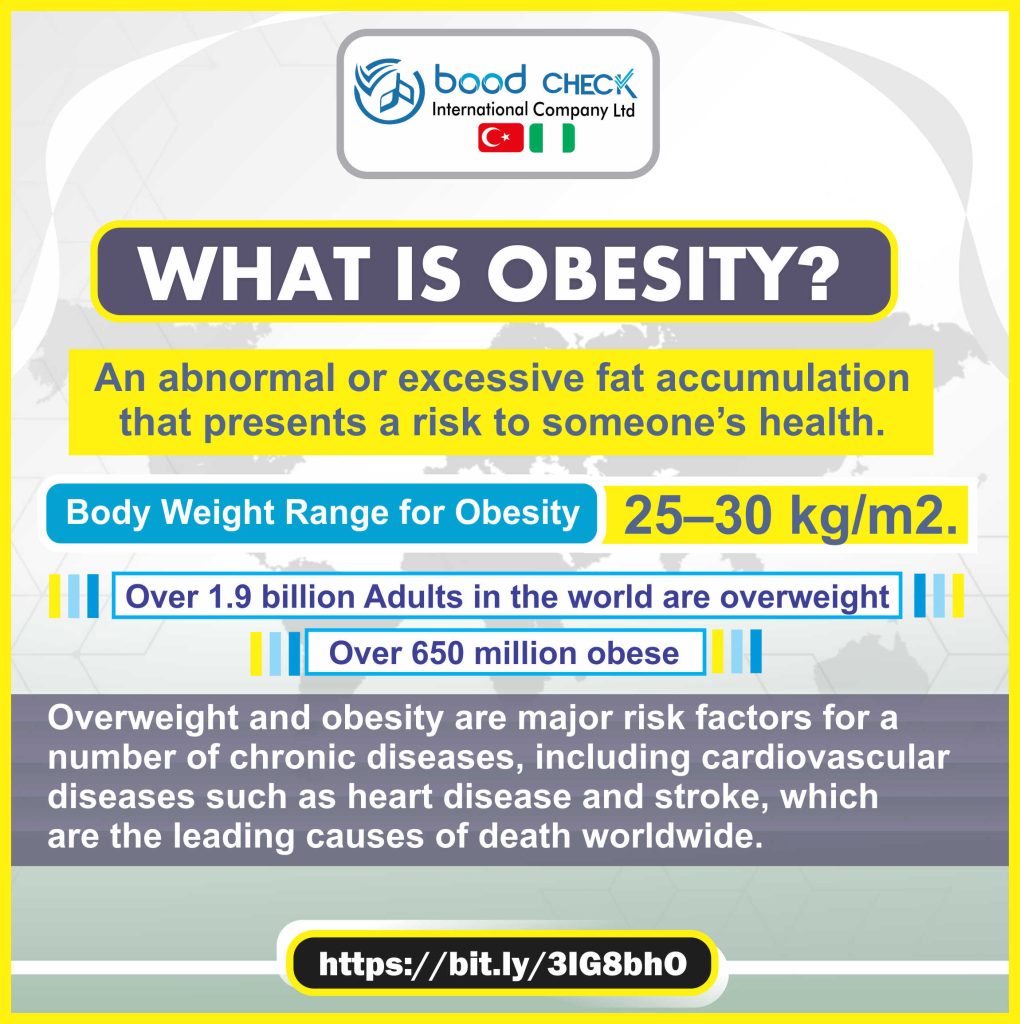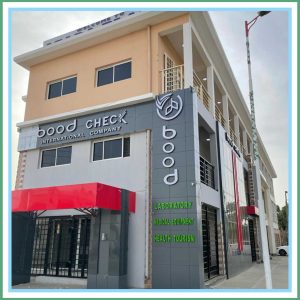Obesity, prevention, how and where to get cholesterol test in Kano state Nigeria

Obesity has become common in most parts of Africa, with particular focus on Nigeria, even as a developing country. Obesity comes from the word “Obese” which is when the body mass index (BMI) of a person’s weight divided by the square of the person’s height is over 30 kg/m2. For someone to be said to be overweight/obese the body weight range is from 25–30 kg/m2.
WHAT IS OBESITY?
Obesity according to WHO is defined as abnormal or excessive fat accumulation that presents a risk to someone’s health. Obesity has grown to become an epidemic as over 4 million people died in 2017 according to the global burden of disease.
The number of Children and Adults becoming overweight worldwide has continue to grow as records have it that from 1975 to 2016 the age bracket of Obese persons has been between 5–19 years and this has increased more than four-fold from 4% to 18% globally.
Obesity is been described as a double burden of malnutrition, as today more people are obese than underweight in most parts of the world except sub-Saharan Africa and Asia. Before now obesity was been considered as a problem in high-income countries but that has changed now as overweight and obesity are now dramatically on the rise in even low- and middle-income countries particularly in urban settings. Surprisingly, the vast majority of overweight or obese children now live in developing countries like Nigeria, where the rate of increase has been more than 30% higher than that of developed countries
Overweight and obesity are major risk factors for a number of chronic diseases, including cardiovascular diseases such as heart disease and stroke, which are the leading causes of death worldwide. Being overweight can also lead to diabetes and its associated conditions, including blindness, limb amputations, and the need for dialysis. Rates of diabetes have quadrupled since around the world since 1980. Carrying excess weight can lead to musculoskeletal disorders including osteoarthritis. Obesity is also associated with some cancers, including endometrial, breast, ovarian, prostate, liver, gallbladder, kidney and colon. The risk of these non-communicable diseases increases even when a person is only slightly overweight and grows more serious as the body mass index (BMI) climbs.
Obesity in childhood is associated with a wide range of serious health complications and an increased risk of premature onset of related illnesses. Studies have found that without intervention, children and adolescents with obesity will likely continue to be obese into adulthood.
Many of the causes of overweight and obesity are preventable and reversible. However, no country has yet to reverse the growth of this epidemic. Although other factors are involved, the fundamental cause of obesity is an imbalance of calories consumed and calories expended. As global diets have changed in recent decades, there has been an increase in the consumption of energy-dense foods high in fat and free sugars. There has also been a decrease in physical activity due to the changing nature of many types of work, more access to transportation and increased urbanization.
Lowering the risk of overweight and obesity includes reducing the number of calories consumed from fats and sugars, increasing the portion of daily intake of fruit, vegetables, legumes, whole grains and nuts, and engaging in regular physical activity (60 minutes per day for children and 150 minutes per week for adults). In babies, studies have shown that exclusive breastfeeding from birth to 6 months of age reduces the risk of infants becoming overweight or obese.
The latest report on overweight and obesity has it that 1.9 billion Adults in the world were overweight in 2016, with 650 million obese, while 39% of Adults were overweight in 2016 and 13% were obese. 38.3 million Children under 5 were overweight or obese in 2019.
TEST TO DETERMINE FATTY DEPOSITS IN THE BODY
To check fatty deposits in the body, a complete cholesterol test is carried out, it is also called “LIPID PANEL” or “LIPID PROFILE”, and this is a blood test that can measure the amount of cholesterol and triglycerides in your blood.
A cholesterol test can help determine your risk of the buildup of fatty deposits (plaques) in your arteries that can lead to narrowed or blocked arteries throughout your body (atherosclerosis). A cholesterol test is an important tool. High cholesterol levels often are a significant risk factor for coronary artery disease.
SYMPTOMS OF HIGH CHOLESTEROL?
High cholesterol usually causes no signs or symptoms. A complete cholesterol test is done to determine whether your cholesterol is high and to estimate your risk of heart attacks and other forms of heart disease and diseases of the blood vessels.
A complete cholesterol test includes the calculation of four types of fats in your blood:
- Total cholesterol: This is a sum of your blood’s cholesterol content.
- Low-density lipoprotein (LDL) cholesterol: This is called the “bad” cholesterol. Too much of it in your blood causes the buildup of fatty deposits (plaques) in your arteries (atherosclerosis), which reduces blood flow. These plaques sometimes rupture and can lead to a heart attack or stroke.
- High-density lipoprotein (HDL) cholesterol: This is called the “good” cholesterol because it helps carry away LDL cholesterol, thus keeping arteries open and your blood flowing more freely.
- Triglycerides: This type of test is used to know the type of fat in the blood. When you eat, your body converts calories it does not need into triglycerides, which are stored in fat cells. High triglyceride levels are associated with several factors, including being overweight, eating too many sweets or drinking too much alcohol, smoking, being sedentary, or having diabetes with elevated blood sugar levels.
WHO SHOULD GET A CHOLESTEROL TEST?
It is common to have patients come for Cholesterol Test, as this test is not limited to just Overweight persons, a medical doctor will recommend this test if a person falls under any of this categories and is in need of medical attention;
- Have a family history of high cholesterol or heart attacks
- Are physically inactive
- Have diabetes
- Eat an unhealthy diet
- Smoke cigarettes
People undergoing treatment for high cholesterol require regular cholesterol testing to monitor the effectiveness of their treatments.
WHERE TO GET TESTED FOR CHOLESTEROL?
At Asada Plaza, Off Maiduguri Road, farm center road, Behind A.Y Mai Kifi Filling station, Tarauni, Kano State, Nigeria, we operate a fully functional Digital walk in laboratory called “Boodcheck Turkish International Laboratory“.

We have the capacity to conduct Cholesterol Test daily at our Ultra-modern facility and this test Turn Around Time (T.A.T) is 1hr which means in 1hr time after the test, your result will be ready. For the convenience of our Patients, we offer Sample collection services, which means we can have an appointment/booking with you and then come to receive the required sample from your place of work or house, this applies to other tests (over 2000 investigations) we carry out and when the test result is out, you can check on our website for your test result or request we send it to you via Email/Whatsapp.
RISK ASSOCIATED WITH CHOLESTEROL TEST
There is little risk in getting a cholesterol test at our facility. You might have soreness or tenderness around the site where your blood is drawn.
HOW YOU PREPARE FOR THE TEST?
You are generally required to fast, consuming no food or liquids other than water, for nine to 12 hours before the test.
WHAT YOU CAN EXPECT
DURING THE PROCEDURE
We advice patients to come for their Cholesterol test which is a blood test early in the morning, and we support this by also resuming early (8am Monday-Saturday).

Blood is drawn from a vein, usually from your arm. Before the needle is inserted, the puncture site is cleaned with antiseptic and an elastic band is wrapped around your upper arm. This causes the veins in your arm to fill with blood.

After the needle is inserted into your arm and we make use of vacutainers to collect small amount of blood. The band is then removed to restore circulation, and blood continues to flow into the vacutainer.
 Once enough blood is collected, the needle is removed and the puncture site is covered with a bandage.
Once enough blood is collected, the needle is removed and the puncture site is covered with a bandage.
The procedure will likely take a couple of minutes and because it is been carried out by our professional laboratory scientists at the phlebotomy, it is relatively painless.
AFTER THE PROCEDURE
There are no precautions you need to take after your cholesterol test, eating at this point is important.
RESULTS
In Kano State Nigeria, at Boodcheck Turkish Laboratory, our cholesterol levels are measured in milligrams (mg) of cholesterol per deciliter (dL) of blood.
HOW TO PREVENT OBESITY
- Choosing healthier foods (whole grains, fruits and vegetables, healthy fats and protein sources) and beverages
- Limiting unhealthy foods (refined grains and sweets, potatoes, red meat, processed meat) and beverages (sugary drinks)
- Increasing physical activity
- Limiting television time, screen time, and other “sit time”
- Improving sleep
- Reducing stress
From us at Boodcheck International Laboratory, we thank you for reading and hope to see you soon.